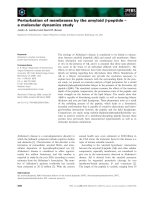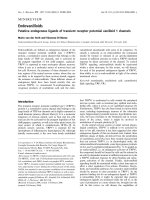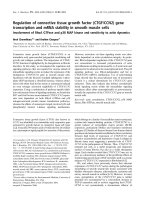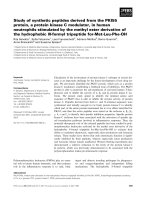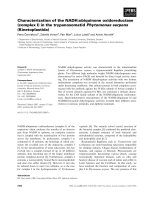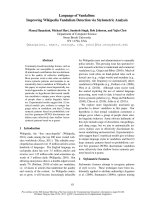Báo cáo khoa học: "Study of endogenous plant growth Douglas fir I. Cytokinin analysis" ppsx
Bạn đang xem bản rút gọn của tài liệu. Xem và tải ngay bản đầy đủ của tài liệu tại đây (132.17 KB, 3 trang )
Study
of
endogenous
plant
growth
substances
in
Douglas
fir I.
Cytokinin
analysis
N. Imbault
P.
Doumas
C. Joseph
M.
Bonnet-Masimbert
2
1
Laboratoire
des
Composes
Ph6noliques,
Université
d’Orl6ans,
BP
6769,
45067
Orleans
Cedex
02, and
2
INRA,
Station
dAm6lioration
des
Arbres
Forestiers,
Ardon,
45i60
Clivet,
France
Introduction
To
ascertain
the
part
played
by
a
natural
substance
in
a
biological
phenomenon,
it
is
necessary
to
follow
the
endogenous
evolu-
tion
of
this
compound
during
the
induction
of
the
process.
This
is
a
real
problem
with
plant
growth
substances
(PGS).
Indeed,
their
very
low
concentrations
in
tissues
make
PGS
difficult
to
quantify.
Because
of
their
sensitivity
and
specificity,
immuno-
logical
methods
have
been
adapted
to
the
analysis
of
PGS
and
enable,
in
some
cases,
measurements
at
the
level
of
a
single
organ,
as
reported
for
principally
herbaceous
species
(Weiler,
1984).
In
this
paper,
some
of
their
applications
to
the
woody
plant,
Douglas
fir
(Pseudotsuga
menziesii
Mirb.),
are
presented:
purifica-
tion
by
immunoaffinity
chromatography
(IAC)
and
measurement
by
an
enzyme-
linked
immunosorbent
assay
(ELISA)
or
a
radioimmunoassay
(RIA).
Materials
and
Methods
Material
The
study
was
performed
on
sexual
buds
of
Douglas
fir.
Cytokinin
isolation
Cytokinins
were
extracted
with
80%
methanol
in
phosphate
buffer
(pH
7.2).
After
concentration,
the
extracts
were
passed
through
a
diethylami-
noethyl-cellulose
column and
purified
either
on
an
immunoaffinity
(IA)
column
(as
described
below)
or
on
an
octadecylsilica
one.
Cytokinins
were
then
separated
by
high-performance
liquid
chromatography
(HPLC)
using
a
reverse
phase
column
(MacDonald
et al.,
1981)
and
measured
either
by
UV
absorption
or
by
ELISA
or
RIA
(as
reported
below).
Immunological
methods
For
IAC
and
EL
J
SA
procedures,
monoclonal
antibodies
were
raised
against
cytokinins
conju-
gated
to
bovine
serum
albumin
(MacDonald
and
Morris,
198!i).
IA
columns
of
1
ml
each
contained
equal
amounts
of
anti-ribosylzeatin
n
(anti-RZ)
and
anti-isopenteny!adenosine
(anti-
IPA)
antibodies
coupled
to
a
cellulose
matrix.
With
this
mixture
of
antibodies,
IAC
was
performed
according
to
MacDonald
and
Morris
(1985).
Thus,
the
usual
cytokinin
bases
and
ribosides
were
recognized.
ELISA
was
perform-
ed
as
described
in
Bataille
et
al.
(1987);
detec-
tion
limit
and
range
were
15
pg
and
20-5000
pg,
respectively.
RIA
was
done
according
to
MacDonald
et
al.
(1981)
using
polyclonal
anti-
cytokinin
antibodies;
detection
limit
and
range
here
were,
50
pg
and
100-5000
pg,
respec-
tively.
Fig.
1
shows
the
HPLC
chromatogram
of
one
extract
from
a
female
bud
of
Douglas
fir
subjected
to
IAC
(B)
or
not
(A).
IAC
cleared
the
extract
of
UV
absorbing
com-
pounds.
Further
cytokinin
quantification
performed
by
RIA
on
HPLC
fractions
demonstrated
no
significant
losses
of
these
PGS
through
iAC.
Therefore,
IAC,
which
retained
only
immunologically
reac-
tive
compounds,
acted
as
a
selective
filter
enabling
quantification
by
integration
of
the
peaks.
In
Fig.
2,
radioimmunohistograms
of
HPLC
male
(A)
and
female
(B)
bud
ex-
tracts
are
represented.
A
RZ-like
sub-
stance
exists
in
both
male
and
female
buds
and
quantities
were
very
similar.
Furthermore,
a
peak,
called
C,
which
did
not
co-chromatograph
with
any
cytokinin
standard,
was
only
present
in
female
bud
extracts.
Thus,
this
measurement
method
made
it
possible
to
determine molecules
other
than
the
standard
ones.
These
results
were
confirmed
by
ELISA.
Discussion
and
Conclusion
To
study
the
evolution
of
cytokinins
in
Douglas
fir
tissues,
immunological
methods
can
be
used.
Because
of
their
sensitivity,
they
need
only
low
quantities
of
plant
material.
However,
the
detection
limit
by
UV
absorpi:ion
(254
nm)
after
IAC
was
only
1-5
ng.
For
small
samples,
the
more
sensitive
ELISA
or
RIA
(15
or
50
pg)
could
be
used.
Thus,
despite
the
inherent
diffi-
culties
of
the
woody
material,
PGS
analy-
sis
is
possible
and
practical
at
the
organ
level,
where
physiological
processes
occur.
One
application
of
this
possibility
was
illustrated
by
the
study
of
Imbault
et
al.
(1988),
which
showed
the
intervention
of
IP
and
IPA
in
Douglas
fir
flowering.
References
Bataille
A.,
Dournas
P.,
Zaerr J.B.
&
Morris
R.O.
(1987)
Comparison
of
ELISA
and
RIA
for
cyto-
kinin
analysis.
Plant
Physiol.
83
(suppl.),
96
Imbault
N.,
Tardieu
L,
Joseph
C.,
Zaerr
J.B.
&
Bonnet-Masimbert
M.
(1988)
Possible
role
of
isopentenyladenine
and
isopentenyladenosine
in
flowering
of
Pseudotsuga
menziesii:
endo-
genous
variations
and
exogenous
applications.
Plant.
Physiol.
Biochem.
26,
289-295
MacDonald
E.M.S.
&
Morris
R.O.
(1985)
Isola-
tion
of
cytokinins
by
immunoaffinity
chroma-
tography
and
analysis
by
high-performance
li-
quid
chromatography-radioimmunoassay.
Me-
thods
Enzymol. 110,
347-358
MacDonald
E.M.S.,
Akiyoshi
D.E.
&
Morris
R.O.
(1981)
Combined
high-performance
liquid
chro-
matography-radioimmunoassay
for
cytokinins.
J.
Chromatogr.
214, 101-109
Weiler
E.W.
(1984)
Immunoassay
of
plant
growth
regulators.
Annu.
Rev.
Plant
Physiol.
35,
85-95
